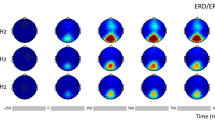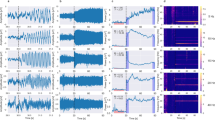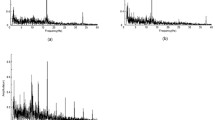Abstract
Evidence is presented that a neurophysiologically-inspired mathematical model, originally developed for the generation of spontaneous EEG (electroencephalogram) activity, can produce VEP (visual evoked potential)-like waveforms when pulse-like signals serve as input. It was found that the simulated VEP activity was mainly due to intracortical excitatory connections rather than direct thalamic input. Also, the model-generated VEPs exhibited similar relationships between prestimulus EEG characteristics and subsequent VEP morphology, as seen in human data. Specifically, the large correlation between the N1 amplitude and the prestimulus alpha phase angle, and the insensitivity of P2 to the latter feature, as observed in actual VEPs to low intensity flashes, was also found in the model-generated data. These findings provide support for the hypothesis that the spontaneous EEG and the VEP are generated by some of the same neural structures and that the VEP is due to distributed activity, rather than dipolar sources.
Similar content being viewed by others
References
Andersen P, Sears TA (1964) The role of inhibition in the phasing of spontaneous thalamo-cortical discharges. J Physiol 173:459–480
Andersson SA, Holmgren E, Manson JR (1971) Localized thalamic rhythmicity induced by spinal and cortical lesions. Electroencephal Clin Neurophysiol 31:347–356
Babloyantz A, Salazar JM, Nicolis C (1985) Evidence of chaotic dynamics of brain activity during the sleep cycle. Phys Lett 111A. 152–156
Barrett G (1986) Analytic techniques in the estimation of evoked potentials. In: Lopes da Silva LH, Storm van Leeuwen W, Rémond A (eds) Clinical applications of computer analysis of EEG and other neurophysiological signals. Elsevier Scientific Publishers, Amsterdam, pp 311–333
Brandt ME (1989) The relationship between prestimulus EEG and visual evoked potentials. Ph. D.-dissertation, Biomedical Engineering Program, University of Houston, Houston
Brazier MAB (1958) Studies of evoked responses by flash in man and cat. In: Reticular formation of the brain. Little Brown & Co. Boston, pp 151–176
Brazier MAB (1964) Evoked responses recorded from the depths of the human brain. Ann NY Acad Sci 112:33–59
Cotterill RMJ (eds) (1988) Computer simulation in brain science. Cambridge University Press, Cambridge
Curtis DR, Eccles JC (1957) The time course of excitatory and inhibitory synaptic action. J Physiol 145:522
Douglas RJ, Martin KAC, Whitteridge D (1989) A canonical microcircuit for neocortex. Neural Computat 1:480–488
Ducati A, Fava E, Motti EDF (1988) Neuronal generators of the visual evoked potentials: intracerebral recordings in awake humans. Electroencephal Clin Neurophysiol 71:89–99
Fester D, Lindström S (1984) Neuronal circuitry of the cat visual cortex. In: Edelman GM, Gall WE, Cowan WM (eds) Dynamic aspects of neocortical function. John Wiley, New York, pp87–103
Freeman WJ (1975) Mass action in the nervous system. Academic Press, New York
Freeman WJ (1987a) Analytic techniques in the search for the physiological basis of the EEG. In: Gevins AS, Rémond A (eds) Methods of analysis of brain electrical and magnetic signals. EEG Handbook, vol 1. Elsevier, Amsterdam
Freeman WJ (1987b) Simulation of chaotic EEG patterns with a dynamical model of the olfactory system. Biol Cybern 56:139–150
Glass L, Mackey MC (1988) From clocks to chaos, the rhythms of life. Princeton University Press, Princeton
Goff WR, Allison T, Vaughan Jr HG (1978) The functional neuroanatomy of the event-related potentials. In: Callaway E, Tueting P, Koslow SH (eds) Event-related brain potentials in man. Academic Press, New York, pp 1–79
Jansen BH, Brandt ME (1991) The effect of the phase of prestimulus alpha activity on the averaged visual evoked response. Electroencephal Clin Neurophysiol 80:241–250
Kandel ER, Schwartz JH (1985) Principles of neural science. Elsevier, Amsterdam
Katznelson RD (1981) Normal modes of the brain: neuroanatomical basis and a physiological theoretical model. In: Nunez P (eds) Electric fields of the brain: the neurophysics of EEG. Oxford University Press, New York, pp 401–442
Kelly DH (1961) Visual response to time-dependent stimuli. II. Single-channel model of the photopic visual system. J Opt Soc Am 51: 747–754
Koch C, Segev I (eds) (1989) Methods in neuronal modeling: from synapses to networks. MIT Press, Cambridge
Lopes da Silva FH, Hoeks A, Zetterberg LH (1974) Model of brain rhythmic activity. Kybernetik 15: 27–37
Lopes da Silva FH Rotterdam A van, Barts P, Heusden E van, Burr W (1976) Model of neuronal populations. The basic mechanism of rhythmicity. In: Corner MA, Swaab DF (eds) Progress in brain research, vol 45. Elsevier, Amsterdam, pp 281–308
Lopes da Silva FH, Storm van Leeuwen W (1977) The cortical sources of the alpha rhythm. Neurosci Lett 6:237–241
MacGregor RJ (1987) Neural and brain modeling. Academic Press, New York
Mast J, Victor JD (1991) Fluctuations of steady-state VEPs: Interaction of driven evoked potentials and the EEG. Electroencephal Clin Neurophysiol 78:389–401
Mountcastle VB (1957) Modality and topographic properties of single neurons of cat's somatic sensory cortex. J Neurophysiol 20: 408–434
Nunez PL (1981) Electric fields of the brain: the neurophysics of EEG. Oxford University Press, New York
Pineda JA, Holmes TC, Foote SL (1991) Intensity-amplitude relationships in monkey event-related potentials: parallels to human augmenting-reducing responses. Electroencephal Clin Neurophysiol 78:456–465
Rapp PE, Zimmerman ID, Albano AM, deGuzman GC, Greenbaum NN, Bashore TR (1985) Experimental studies of chaotic neural behavior: cellular activity and electroencephalographic signals. In: Othmer HG (eds) Nonlinear oscillations in biology and chemistry. Springer, Berlin Heidelberg New York, pp 175–205
Rogers RL, Papanicolaou AC, Baumann SD, Sydjarï C, Eisenberg HM (1990) Neuromagnetic evidence of a dynamic excitation pattern generating the N100 auditory response. Electroencephal Clin Neurophysiol 77:237–240
Rogers RL, Baumann SD, Papanicolaou AC, Bourbon TW, Alagarsamy S, Eisenberg HM (1991) Localization of the P3 sources using magnetoencephalography and magnetic resonance imaging. Electroencephal Clin Neurophysiol 79:308–321
Rotterdam A van, Lopes da Silva FH, van den Ende J, Viergever A, Hermans AJ (1982) A model of the spatial-temporal characteristics of the alpha rhythm. Bull Math Biol 44:283–305
Skarda A, Freeman WJ (1987) How brains make chaos in order to make sense of the world. Behav Brain Sci 10:161–195
Steriade M, Llinás R (1988) The functional states of the thalamus and the associated neuronal underplay. Physiol Rev 68: 649–742
Szentángothai J (1978) The local neuronal apparatus of the cerebral cortex. In: Cerebral correlates of conscious experience. Elsevier/North Holland Biomedical Press, Amsterdam, pp 131–138
Traub RD, Miles R, Wong RKS (1988) Large scale simulations of the hippocampus. IEEE Eng Med Biol 7:31–38
Toyama K, Matsunami K, Ohno T, Tokashiki S (1974) An intracellular study of neuronal organization in visual cortex. Exp Brain Res 21:45–66
Watson AB, Nachmias J (1977) Patterns of temporal integration in the detection of grating. Vision Res 17:893–902
Wilson HR, Cowan JD (1972) Excitatory and inhibitory interaction in localized populations of model neurons. Biophys J 12:1–24
Wilson CL, Babb TL, Halgren E, Crandall PH (1983) Visual receptive fields and response properties of neurons in human temporal lobe and visual pathways. Brain 106:473–502
Winfree AT (1987) When time breaks down. Princeton University Press, Princeton
Zetterberg LH, Kristiansson L, Mossberg K (1978) Performance of a model for a local neuron population. Biol Cybern 31:15–26
Zouridakis G (1990) Nonlinear modeling of EEG and VEP activity. M. Sc.-Thesis, Biomedical Engineering Program, University of Houston, Houston
Author information
Authors and Affiliations
Rights and permissions
About this article
Cite this article
Jansen, B.H., Zouridakis, G. & Brandt, M.E. A neurophysiologically-based mathematical model of flash visual evoked potentials. Biol. Cybern. 68, 275–283 (1993). https://doi.org/10.1007/BF00224863
Received:
Accepted:
Issue Date:
DOI: https://doi.org/10.1007/BF00224863




